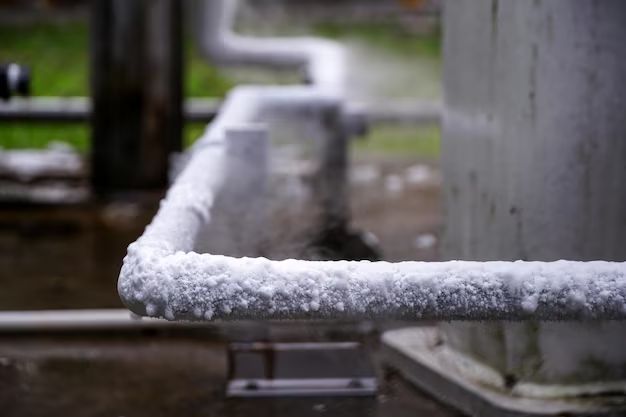Gas freezing temperatures vary depending on the type of gas. Gases turn to liquids and freeze at very low temperatures approaching absolute zero (-273.15°C or -459.67°F). Different gases have different freezing points depending on their molecular structure and weight. Freezing points are often expressed in kelvins (K) in science.
Page Contents
Freezing Points of Common Gases
Here are the freezing points of some common gases:
| Gas | Freezing Point (K) | Freezing Point (°C) |
|---|---|---|
| Nitrogen | 63.15 | -210 |
| Oxygen | 54.36 | -218.79 |
| Carbon dioxide | 194.65 | -78.5 |
| Methane | 90.69 | -182.5 |
| Helium | 2.17 | -271 |
| Hydrogen | 14.01 | -259.14 |
As you can see, different gases freeze at very low temperatures approaching absolute zero. Lighter gases like helium and hydrogen freeze closer to absolute zero than heavier molecules like carbon dioxide and nitrogen. The reason is that lighter molecules move faster and have weaker intermolecular attractions, so they remain gaseous at lower temperatures.
Why Do Gases Freeze at Low Temperatures?
Gases are made up of molecules moving freely and rapidly. As a gas is cooled, the molecules slow down and get closer together. At some point, the molecular motion slows enough and the intermolecular attractions become strong enough that the gas condenses into a liquid state. The temperature at which this occurs is the gas’s freezing point.
Cooling a gas further will make the liquid state more ordered and dense until it reaches its freezing point and becomes a solid. The freezing point is the temperature at which the liquid and solid states of the substance are in equilibrium. Cooling beyond this point causes more liquid to freeze into solid.
Different gases have widely varying freezing points depending on:
- Molecular weight – Lighter molecules move faster and have weaker bonds.
- Molecular shape – Spherical molecules pack together better.
- Polarity – Polar molecules have stronger attractions.
- Intermolecular forces – The strength of attractions between molecules.
Lighter, simpler, and nonpolar molecules like helium and hydrogen have very low freezing points near absolute zero. Heavier, complex, and polar molecules like water vapor freeze at higher temperatures.
Predicting Gas Freezing Points
While the freezing point depends on the specifics of each gas, there are some general trends that allow predictions of gas freezing temperatures:
- Lighter molecules freeze at lower temperatures closer to absolute zero.
- Nonpolar molecules freeze at lower temperatures than polar molecules.
- Linear molecules freeze more easily than spherical molecules.
- Smaller molecules freeze more easily than larger complex molecules.
These trends have to do with the strength of intermolecular attractions. The weaker the molecular attractions, the easier it is for the gas to remain gaseous and resist freezing at low temperatures.
Effect of Pressure on Freezing Point
Increasing the pressure applied to a gas raises its freezing point slightly. This is because higher pressure brings molecules closer together, strengthening intermolecular attractions. However, the effect is very small compared to changing the temperature.
Uses of Frozen Gases
Gases frozen into liquid or solid states have a variety of uses and applications. Some examples include:
- Liquid nitrogen – Used as a cryogenic coolant for flash freezing foods, biological samples, and in dermatology treatments.
- Liquid helium – Cools the superconducting magnets in MRI machines and scientific research equipment.
- Liquid oxygen – Used as an oxidizer in rocket fuel with liquid hydrogen.
- Dry ice (solid CO2) – Provides cooling for transporting frozen foods and ice cream. Used for fog effects.
- Liquid hydrogen – Used along with liquid oxygen for rocket propellant.
The ultra-low temperatures of frozen gases create unique properties that lend themselves to specialty applications. However, the process of liquefying and solidifying gases requires complex and energy-intensive equipment like cryogenic tanks and compressors.
Hazards of Extremely Low Temperatures
The freezing points of gases approach absolute zero, the coldest temperature theoretically possible. Working with cryogenic liquids or solids involves many hazards:
- Extreme cold can cause frostbite and tissue damage on contact.
- Condensing gases rapidly contract, creating a freeze burn risk.
- Cryogenic liquids release large volumes of gas when they vaporize.
- Oxygen enrichment fire risks are higher in condensing gases.
- Materials become brittle and may shatter at very low temperatures.
Specialized personal protective equipment like insulated gloves, eye protection, and aprons are required when handling frozen gases. Storage equipment also needs to withstand the temperature extremes and pressure risks.
Conclusion
In summary, gases freeze at temperatures approaching absolute zero, with lighter and nonpolar gases freezing at the lowest temperatures. Cooling gas molecules slows their motion and causes them to condense into liquid and solid states at their freezing point. Frozen gases have applications including rocket fuel, food freezing, and research. But handling these materials at extremely low temperatures near absolute zero also poses safety hazards that must be addressed.
